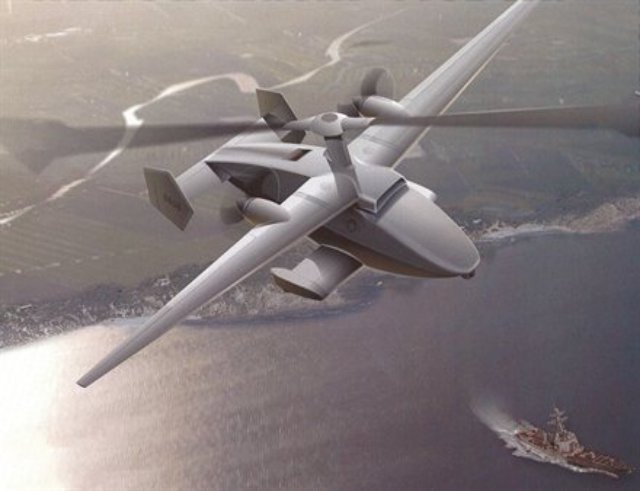 Concept: AAI, via Mike Hirschberg
Concept: AAI, via Mike Hirschberg
is proposing a new vertical-takeoff-and-landing (VTOL) design for the U.S. Navy’s medium-range maritime unmanned aerial system (MRMUAS) requirement.
The Shadow Knight is based on the slowed-rotor/compound (SR/C) concept licensed from Carter Aviation Technologies, but with changes to enable a true hover capability for operation from ships.
AAI has been investigating Carter’s technology because it provides a VTOL capability similar to a helicopter without the complexity of a fully powered rotor, promising reduced acquisition and maintenance costs.
In the SR/C concept, the unpowered rotor is spun up before flight for a “jump” takeoff, lift transfers from the rotor to the wing in forward flight, and the aircraft autorotates to a “zero-roll” landing.
“SR/C could do the mission, but the challenge is that getting on and off the ship requires it to hover longer than SR/C can,” says Tom Bachman, vice president of new products and technology for AAI Unmanned Aircraft Systems.
“We’ve concluded we could power the rotor for takeoff, declutch it so when the aircraft transitions to forward flight it becomes a slowed rotor like the unpowered version, then engage the clutch and power the rotor back to get back on the ship,” he says.
This will require a transmission that the SR/C lacks, but because the rotor is powered only while hovering, the duty cycle — and resultant maintenance burden — will not be as onerous as in a conventional helicopter, AAI argues.
Based on its experience with the U.S. Army’s RQ-7 Shadow UAV, AAI believes the key to meeting the Navy’s requirement to maintain round-the-clock surveillance at 300-nm range is minimizing maintenance per flight hour.
Minimizing maintenance for MRMUAS would be a challenge with a conventional rotorcraft, Bachman says, adding “We can take the goodness of SR/C — the simple rotor head — and apply it to something that could hover.”
Carter is flight testing the SR/C concept using its PAV-4 prototype personal air vehicle, and is building two more for AAI, which plans to use them to develop flight control laws for the Shadow Knight and other potential VTOL vehicles.
AAI is already flying an 80-lb. subscale SR/C test vehicle to define autopilot control laws and has built the rotor for a Shadow-sized VTOL UAV, work on which has been put on the back burner while it develops an improved M2 version of the fixed-wing Shadow. AAI also is developing an SR/C-based VTOL design for the U.S. Defense Advanced Research Projects Agency’s Transformer program to demonstrate a fly-drive tactical vehicle or “flying Humvee.”
MRMUAS is planned as a follow-on to the MQ-8C version of the Navy’s Fire Scout shipboard VTOL tactical UAS, which Northrop Grumman will develop using the larger Bell 407-based Fire-X airframe in place of the Schweizer S-330 light helicopter used for the MQ-8B.
Bachman anticipates the Navy will award three or four MRMUAS study contracts in February with the intent, he believes, of finding out whether industry can exceed the Fire-X’s capability at affordable cost, or whether the service needs to trim its requirements.
Source: Aviation Week
